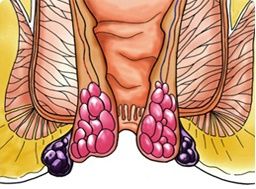 Haemorrhoids, commonly known as piles, are actually present normally in all people. Piles are blood vessels “cushions” located within the anus and the lower rectum. These “cushions” serve a function to provide control of continence, allowing us to pass motion without leaking stools. We notice them only when there is bleeding, pain, prolapse or discharge.
Haemorrhoids, commonly known as piles, are actually present normally in all people. Piles are blood vessels “cushions” located within the anus and the lower rectum. These “cushions” serve a function to provide control of continence, allowing us to pass motion without leaking stools. We notice them only when there is bleeding, pain, prolapse or discharge.
What causes piles?
Long-term constipation and excessive straining during bowel movement are common causes of symptomatic piles. Pregnant ladies are also more prone to develop piles. The elastic tissues supporting the normal piles gradually become stretched and torn.The piles enlarge and protrude; their walls get thinned out and bleed, causing discomfort and itch. At this stage, the piles are considered symptomatic piles or diseased. Symptomatic piles are common in Singapore, affecting about a third of the population.
How are haemorrhoids (piles) treated?
Piles are classified into 4 degrees of severity for the purpose of treatment.
- 1st degree piles: Internal piles, does not protrude from the anus, may bleed.
- 2nd degree piles: Protrude from the anus during bowel movement, but spontaneously retracts on its own.
- 3rd degree piles: Protrude with or without straining, stays protruded but can be pushed back into the anus.
- 4th degree piles: Protrude from the anus and remain permanently outside the anus. Cannot be pushed back at all.
Early symptomatic piles (1st and 2nd degrees) can usually be treated without the need for surgery. Increasing the intake of vegetables and fruits containing high fibre content will improve constipation for most persons and avoid the need for too much straining during bowel movement. Taking sufficient water as well as wholemeal bread or cereals will help too.
Mild internal piles may be treated with medication. Rubber banding of piles is an effective treatment for early stage piles. It does not require anaesthesia and causes minimal discomfort. It can be done in the specialist’s clinic itself.
You should consult your doctor if you have symptoms of piles rather than self-medicate. Symptoms of piles such as bleeding may also be caused by more serious conditions like colorectal cancer. Colorectal cancer is the number one common cancer in Singapore. Your doctor may recommend a colonoscopy, performed by a specialist to check your large intestines internally before treatment of your piles.
Surgery for haemorrhoids/piles
Surgery is considered for the treatment of symptomatic large external piles (3rd and 4th degrees) that will not improve on medical treatment alone. The surgery for piles is performed under anaesthesia as day-surgery. Your doctor will advise you on which is the most appropriate method of treatment for your severity of piles.
Conventional Haemorrhoidectomy
Conventional operation for piles involves removal by cutting them away using a hot electrocautery knife. The wound usually takes 4 to 6 weeks to heal completely. Wound pain and bleeding is common after surgery until the wound heals.
Stapled Haemorrhoidectomy
Stapled haemorrhoidectomy, also known as the Longo’s procedure or PPH (Procedure for Prolapse and Haemorrhoids), is another technique that uses a specialised circular stapler to remove the diseased piles. The device removes the piles and seals the wound with a row of tiny staples. The wounds often heal within 2 weeks and few patients complained of severe pain. view Stapled Haemorrhoidectomy video
THD (Transanal Haemorrhoidal Dearterialisation)
THD is a new surgical treatment of Haemorrhoids/Piles. It uses an ultrasound guide to direct precise suturing of the haemorrhoidal vessels. This result in reduced blood flow and relieved the congestion of the piles. There is minimal pain with this technique of surgery because there is no cutting involved. view THD video
Complications to observe for after haemorrhoids (piles) operation:
Pain during the passage of stools. This may result in constipation or may be due to constipation. It is a vicious cycle. This problem is best treated by prevention. You would usually be prescribed pain-killers and mild laxatives after your operation. You should also drink plenty of water.
Bleeding from the wound is uncommon and often minor. However, if there is large amount of bleeding continuously, you need to seek immediate medical attention.
Infection of the wound is very uncommon but can occur for up to 2 weeks after surgery. It often resolves on its own or after oral antibiotics treatment. Only very rarely does severe infection occur.
There is a small chance of recurrence of piles after operation. But only a small proportion of patients require further treatment.
Prevention
Take enough fibre in your diet, drink plenty of water and avoid straining during bowel movements.



